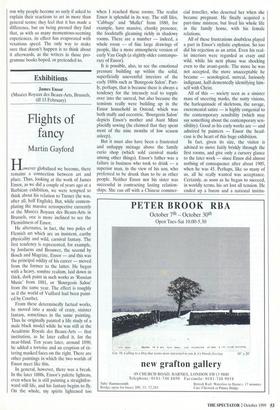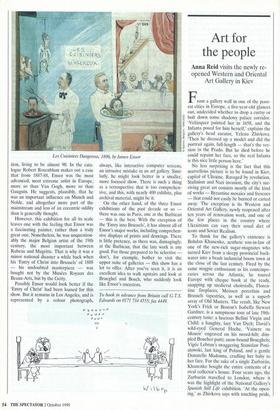Exhibitions
James Ensor
(Musees Royaux des Beaux-Arts, Brussels, till 13 February)
Flights of fancy
Martin Gayford
However globalised we become, there remains a connection between art and place. Thus, looking at the work of James Ensor, as we did a couple of years ago at a Barbican exhibition, we were tempted to think about his relation to Turner (he was, after all, half English). But, while contem- plating the massive retrospective currently at the Muses Royaux des Beaux-Arts in Brussels, one is more inclined to see the Flemishness of Ensor.
He alternates, in fact, the two poles of Flemish art which are an insistent, earthy physicality and wild, carnival fantasy. The first tendency is represented, for example, by Jordaens and Brouwer, the second by Bosch and Magritte. Ensor — and this was the principal oddity of his career — moved from the former to the latter. He began with a heavy, sombre realism, laid down in thick, dark paint in such works as 'Russian Music' from 1881, or 'Bourgeois Salon' from the same year. The effect is roughly as if the world of Vuillard had been paint- ed by Courbet.
From these determinedly factual works, he moved into a mode of crazy, sinister fantasy, sometimes in the same painting. Thus he originally painted a life study of a male black model while he was still at the Academic Royale des Beaux-Arts — that institution, as he later called it, for the near-blind. Ten years later, around 1890, he added a tortoise and an eruption of tit- tering masked faces on the right. There are other paintings in which the two worlds of Ensor meet like this.
In general, however, there was a break. In the later 1880s, Ensor's palette lightens, even when he is still painting a straightfor- ward still life, and his fantasy begins to fly. On the whole, my spirits lightened too when I reached these rooms. The realist Ensor is splendid in its way. The still lifes, 'Cabbage' and 'Mullet' from 1880, for example, have massive, chunky presence, the foodstuffs gleaming richly in shadowy rooms. There are a number — indeed, a whole room — of fine large drawings of people, like a more atmospheric version of early Van Gogh (a slightly older contempo- rary of Ensor).
It is possible, also, to see the emotional pressure building up within the solid, superficially uneventful interiors of the early 1880s such as 'Bourgeois Salon'. Part- ly, perhaps, that is because there is always a tendency for the intensely real to topple over into the surreal, but also because the tensions really were building up in the Ensor household in Ostend, which was both stuffy and eccentric. 'Bourgeois Salon' depicts Ensor's mother and Aunt Mimi placidly sewing (he claimed that they spent most of the nine months of low season asleep).
But it must also have been a frustrated and unhappy menage above the family curio shop (which sold carnival masks among other things). Ensor's father was a failure in business who took to drink — a superior man, in the view of his son, who preferred to be drunk than to be as other people. Neither Ensor nor his sister was successful in contracting lasting relation- ships. She ran off with a Chinese commer-
cial traveller, who deserted her when she became pregnant. He finally acquired a part-time mistress, but lived his whole life in the family home, with his female relations.
All of these frustrations doubtless played a part in Ensor's stylistic explosion. So too did his rejection as an artist. Even his real- ist interiors were regarded as crazy and wild, while his next phase was shocking even to the avant-garde. The more he was not accepted, the more unacceptable he became — scatological, surreal, furiously indignant, half-dementedly identifying him- self with Christ.
All of this — society seen as a sinister mass of sneering masks, the nutty visions, the harlequinade of skeletons, the savage, excremental satire — is highly congenial to the contemporary sensibility (which may say something about the contemporary sen- sibility). Good as his early works are — and admired by painters — Ensor the head- case is the heart of this huge exhibition.
In fact, given its size, the visitor is advised to move fairly briskly through the first rooms, and give only a cursory glance to the later work — since Ensor did almost nothing of consequence after about 1905, when he was 45. Perhaps, like so many of us, all he really wanted was acceptance. Certainly, as soon as he began to succeed, in worldly terms, his art lost all tension. He ended up a baron and a national institu Les Cuisiniers Dangereux, 1896, by James Ensor tion, living to be almost 90. In the cata- logue Robert Rosenblum makes out a case that from 1887-88, Ensor was the most advanced, most extreme artist in Europe, more so than Van Gogh, more so than Gauguin. He suggests, plausibly, that he was an important influence on Munch and No1de, and altogether more part of the mainstream and less of an eccentric oddity than is generally thought.
However, this exhibition for all its scale leaves one with the feeling that Ensor was a fascinating painter, rather than a truly great one. Nonetheless, he was unquestion- ably the major Belgian artist of the 19th century, the most important between Rubens and Magritte. That is why it was a minor national disaster a while back when his 'Entry of Christ into Brussels' of 1888 — his undoubted masterpiece — was bought not by the Musees Royaux des Beaux-Arts, but by the Getty.
Possibly Ensor would look better if the 'Entry of Christ' had been loaned for this show. But it remains in Los Angeles, and is represented by a colour photograph, always, like interactive computer screens, an intrusive mistake in an art gallery. Simi- larly, he might look better in a smaller, more focused show. There is such a thing as a retrospective that is too comprehen- sive, and this, with nearly 400 exhibits, plus archival material, might be it.
On the other hand, of the three Ensor exhibitions of the past decade or so — there was one in Paris, one at the Barbican — this is the best. With the exception of the 'Entry into Brussels', it has almost all of Ensor's major works, including comprehen- sive displays of prints and drawings. There is little pretence, as there was, damagingly, at the Barbican, that the late work is any good. For those prepared to be selective — don't, for example, bother to visit the upper suite of galleries — this show has a lot to offer. After you've seen it, it is an excellent idea to walk upstairs and look at Brueghel and Bosch, who suddenly look like Ensor's ancestors.
To book in advance from Britain call G.T.S. Edwards on 0171 734 4555; fax 4449.











































































 Previous page
Previous page